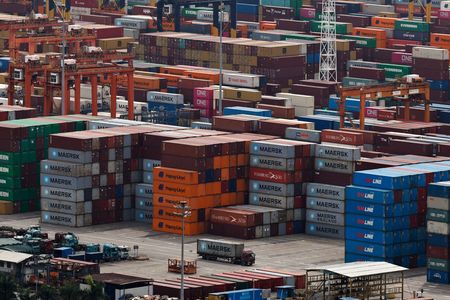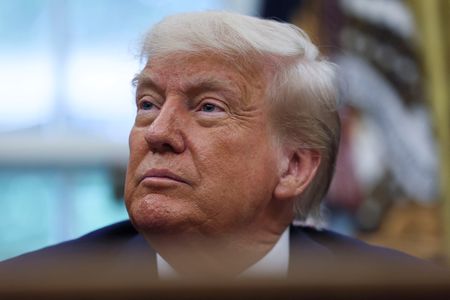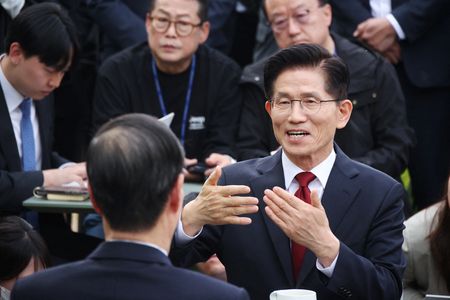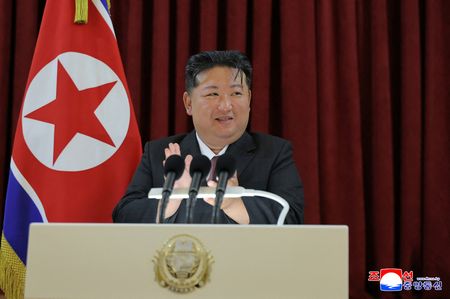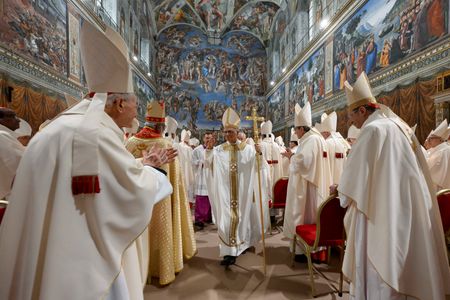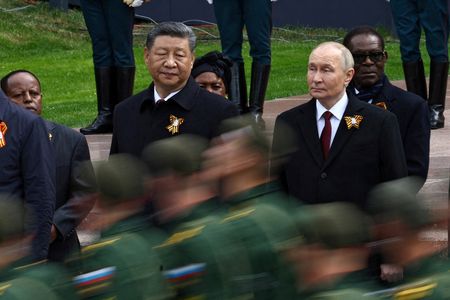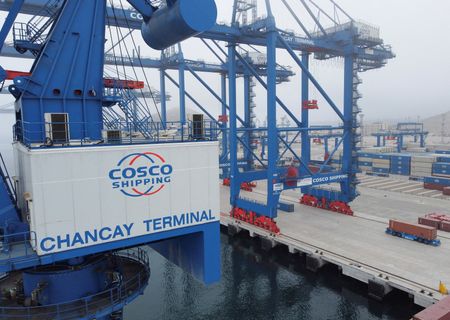By Doina Chiacu and Jeff Mason
WASHINGTON (Reuters) -U.S. President Donald Trump said on Friday an 80% tariff on Chinese goods “seems right,” suggesting for the first time a specific alternative to the 145% levies he has imposed on Chinese imports ahead of closely watched weekend talks between the two countries.
U.S. Treasury Secretary Scott Bessent and chief trade negotiator Jamieson Greer will meet Chinese economic tsar He Lifeng in Switzerland to discuss containing the damaging trade war between the world’s two biggest economies, which has already entangled global supply chains.
Asked how Trump arrived at the 80% figure, White House spokeswoman Karoline Leavitt said, “That was a number the president threw out there, and we’ll see what happens this weekend.”
Trump will not unilaterally bring down tariffs on China, however, she stressed.
“We need to see concessions from them as well,” she said.
China is also sending a top public-security official to the talks in Geneva, a source familiar with the plans said. The development, first reported by the Wall Street Journal, underscores the importance of the issue of fentanyl trafficking to the talks and the wider U.S.-China relationship.
Trump cited fentanyl as the rationale for the initial imposition of punitive import taxes on goods from China, Canada and Mexico earlier this year.
China’s embassy in Washington did not respond to a request for comment.
“China should open up its market to USA – would be so good for them!!! Closed markets don’t work anymore!!!” Trump wrote in an all-caps social media post. “80% tariff on China seems right. Up to Scott B.,” he added moments later.
Trump on Thursday said he expected there to be substantive talks this weekend and predicted U.S. tariffs were likely to come down.
China’s foreign ministry has decried what it calls abusive and bullying economic tactics and said China remains firmly opposed to what it calls an unsustainable approach to trade by the U.S.
Ryan Majerus, partner with the King & Spalding law firm and a former senior Commerce Department official, said the expected decline in port and trade traffic may have created some pressure to start addressing the U.S.-China trade impasse in Geneva.
“I don’t see an easy off-ramp for either party,” he said. “We could see a more limited agreement that lowers the tariff rates to a degree, depending on what China is willing to do.”
Asked by a reporter in the Oval Office on Friday whether he had given Bessent a number reflecting how low he was willing to go, Trump said yes, though he left it unclear whether his bottom-line figure was the same 80% he floated publicly.
“We have to make a great deal for America,” he said. “I put out a number today, 80%, so we’ll see how that all works out.”
The weekend talks come on the heels of Trump’s first agreement with a major trading partner: Thursday’s announcement of a pact with Britain. While that fueled some optimism in markets, it was fairly limited in scope, and a range of details still need to be hammered out.
“The U.S.-U.K. trade agreement may be better than nothing, but it is not significant enough to warrant a change to our forecast,” Nancy Vanden Houten, lead U.S. economist at Oxford Economics, wrote on Friday. “While talks this weekend between U.S. and Chinese officials may yield some progress, expectations for a significant reduction in tariffs seem unwarranted.”
Oxford estimates that lowering tariffs on China to 80% would bring the overall effective import tax rate from all the tariffs imposed by Trump so far to 18% from around 22% now. That would still be treble what Oxford had estimated at the start of Trump’s term and far above the 2-3% average from before he returned to office.
US STOCKS MUTED
While Trump has indicated on several occasions that he expects the tariff rates on China to come down, he had not until now proposed a precise alternative.
Even though 80% is just above half the current rate, it remains extraordinarily high, above even the hefty 60% rate that Trump proposed while campaigning for president last year. It was not clear how it would be received by China amid what Bessent has already cast as an effective trade embargo between the two countries.
What level tariff rates settle at – and not just for China – has been a central focus for investors rattled by months of financial market volatility arising from the chaotic rollout of Trump’s aggressive trade policies.
U.S. stocks, which have recouped a significant chunk of their losses since mid-February’s record high, finished slightly lower for the week after a quiet session on Friday. The dollar was weaker against a basket of major trading partners’ currencies.
Since taking office in January, Trump has hiked the tariffs paid by U.S. importers for goods from China to 145%, in addition to those he imposed on many Chinese goods during his first term and the duties levied by the Biden administration.
China hit back by imposing export curbs on some rare earth elements, vital for U.S. manufacturers of weapons and electronic consumer goods, and raising tariffs on U.S. goods to 125%. It also imposed extra levies on some products including soybeans and liquefied natural gas.
Trump’s push on tariffs is widely seen to be elevating risks to the U.S. economy, with concerns that they will lift prices for American consumers and businesses while at the same time cutting into the demand that has propped up the job market.
Trump is already facing dropping approval ratings as Americans brace to pay more for clothes, electronics, toys and countless other goods that emerge from Chinese factories.
China’s government is seeking to mitigate closures, bankruptcies and job losses at manufacturers struggling to find viable alternatives to the U.S. market.
Representing the meeting’s host, Swiss Vice President Guy Parmelin, who also serves as economic minister, emerged from separate bilateral meetings in Geneva with the U.S. and Chinese delegations with optimistic words.
“It’s already a success,” Parmelin told reporters. “The two sides are talking … If a road map can emerge and they decide to continue discussions, that will lower the tensions.”
(Reporting by Doina Chiacu and Jeff Mason in Washington; additional reporting by Emma Farge in Geneva and Antoni Slodkowski in Beijing; writing by Doina Chiacu, Jonathan Allen and Joseph Ax; editing by Philippa Fletcher, Andrea Ricci, Mark Heinrich, Diane Craft, Marguerita Choy and David Gregorio)

